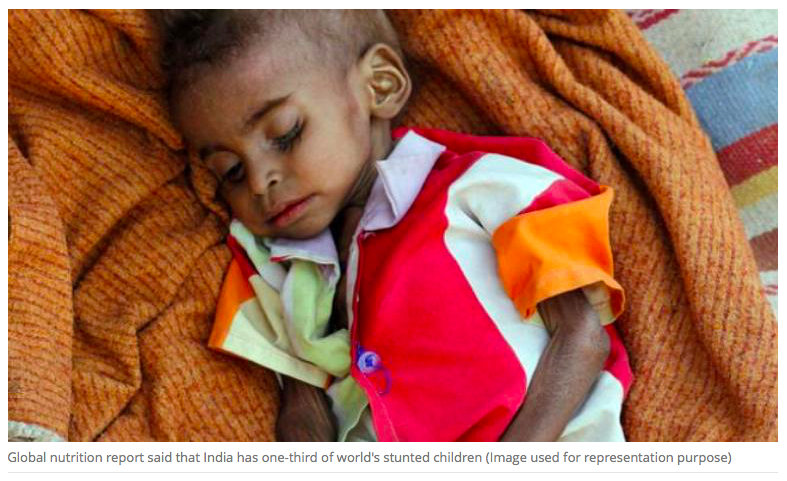India has one-third of world's stunted children: Global nutrition report
 With 46.6 million children who are stunted, India tops the list of countries followed by Nigeria (13.9 million) and Pakistan (10.7 million), the Global Nutrition Report 2018 said.
With 46.6 million children who are stunted, India tops the list of countries followed by Nigeria (13.9 million) and Pakistan (10.7 million), the Global Nutrition Report 2018 said.
India is facing a major malnutrition crisis as it holds almost a third of the world's burden for stunting, according to a global nutrition report published Thursday.
With 46.6 million children who are stunted, India tops the list of countries followed by Nigeria (13.9 million) and Pakistan (10.7 million), the Global Nutrition Report 2018 said.
Stunting, or low height for age, is caused by long-term insufficient nutrient-intake and frequent infections.
India also accounted for 25.5 million children who are "wasted" (having low weight for height), followed by Nigeria (3.4 million) and Indonesia (3.3 million).
Wasting, or low weight for height, is a strong predictor of mortality among children under five. It is usually the result of acute significant food shortage and/or disease.
"More than half of the world's children impacted by wasting (26.9 million) live in South Asia. Of the three countries that are home to almost half (47.2 per cent) of all stunted children, two are in Asia, with India having 46.6 million (31 per cent) and Pakistan having 10.7 million," the report said.
Globally 150.8 million children under five years are stunted and 50.5 million are wasted, the report said.
India also figures among the set of countries that has more than a million overweight children. The other nations are China, Indonesia, India, Egypt, US, Brazil and Pakistan.
In four countries, more than a fifth of all children are overweight -- Ukraine, Albania, Libya and Montenegro.
Of the 38.3 million children globally overweight, 5.4 million are in South Asia and 4.8 million are in East Asia.
Prevalence of overweight children is the highest in upper-middle income countries and the lowest in low-income countries.
In urban areas, there are 7.1 per cent overweight children on average, whereas in rural areas 6.2 per cent children are overweight. It is slightly more common among boys (6.9 per cent) than girls (6.1 per cent), the report highlighted.
As with obesity, among adults, women are more overweight than among men (39.2 pc and 38.5 pc respectively in 2016). Conversely, diabetes is more common among men than women (9.0 pc and 7.9 pc respectively in 2014).
Of the 141 countries analysed, 88 per cent (124 countries) experience more than one form of malnutrition, the report said.
The report referred to a study by the International Food Policy Research Institute (IFPRI) which used district-level aggregate data from the 20152016 National and Family Health Survey, covering 601,509 households in 604 districts in India, to understand the causes of the spatial variation.
Researchers used mapping and descriptive analyses to understand spatial differences in distribution of stunting. The mapping showed that stunting varies greatly from district to district (12.4 to 65.1 pc), with 239 of 604 districts having stunting levels above 40 per cent.
The study found that factors such as women's low BMI accounted for 19 per cent of the difference between the low versus high-burden districts. Other influential gender-related factors included maternal education (accounted for 12 pc), age at time of marriage (7 pc) and antenatal care (6 pc).
Children's diets (9 pc), assets (7 pc), open defecation (7 pc) and household size (5 pc) were also influential.









